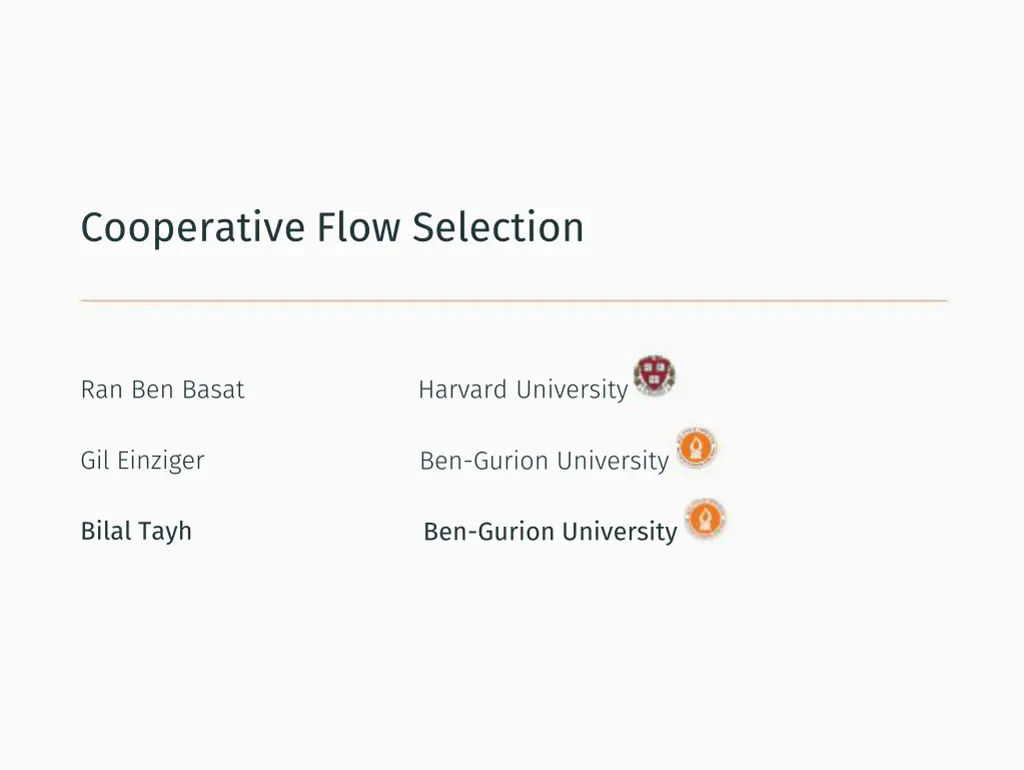
Cooperative Flow Selection and Network Wide Measurement Study
"Explore Cooperative Flow Selection algorithms achieving optimal flow coverage, evaluated on Fat Tree topology with NMP structure analysis. Dive deeper into challenges, current solutions, and experiments comparing CFS and CFS-FR in network flow measurement architecture."
Download Presentation

Please find below an Image/Link to download the presentation.
The content on the website is provided AS IS for your information and personal use only. It may not be sold, licensed, or shared on other websites without obtaining consent from the author. If you encounter any issues during the download, it is possible that the publisher has removed the file from their server.
You are allowed to download the files provided on this website for personal or commercial use, subject to the condition that they are used lawfully. All files are the property of their respective owners.
The content on the website is provided AS IS for your information and personal use only. It may not be sold, licensed, or shared on other websites without obtaining consent from the author.
E N D
Presentation Transcript
Cooperative Flow Selection Ran Ben Basat Harvard University Gil Einziger Ben-Gurion University Bilal Tayh Ben-Gurion University
Network Wide Flow Measurement Identifying attacks. Detecting load imbalance. Fine-grained traffic analysis. Routing. 1/42
Challenges 3/42
Current Solutions Works that pursue some form of communication between the NMPs. Works that don t require communication between the NMPs. 4/42
Current Solutions Our work belongs to: Works that don t require communication between the NMPs. 5/42
Our Contribution We suggest the Cooperative Flow Selection (CFS) and (CFS-FR) algorithms that achieve near-optimal flow coverage. 6/42
The Experiment We evaluated CFS and CFS-FR and explored their benefits and limitations compared to prior works. 7/42
Network Topology We evaluate our algorithms on Fat Tree topology with parameter k=8. 8/42
NMP Structure 9/42
NMP Structure NMP Grade(2633) is 0.3 10/42
NMP Structure 11/42
Calculating the Grade We assign each flow x with Hash Value h(x) within the unit circle (0,1). We assign a Target Value for each possible TTL value. The grade of a flow in a NMP is the distance between the Hash Value and the Target Value. 13/42
Determining the Target Value We suggest two approaches for determining the target values: The Greedy approach. The Folding approach. 19/42
The Greedy approach We propose the following algorithm: Arbitrary select a value for T(255). We determine T(254) to be the point with maximal distance from T(255). We choose T(253) the point that maximize the minimal distance to T(255) and T(254). If there is multiple such points we choose one of them. 20/42
The Folding approach We propose the following algorithm: Arbitrary select a value for T(255). We determine T(254) to be all the points with maximal distance from T(255). We choose T(253) to be all the points that maximize the minimal distance to T(255) and T(254). 25/42
Folding The downside of this approach is that the number of values of the target multiplies by 2 each time the TTL decreases by 1. To solve this we suggest calculating the distance between the targets and the hash using folding. 30/42
Folding We will look at the unit circle as a plane. When the TTL is 255 we will calculate the distance between the target and the hash directly. For the TTL 254 we will calculate the distance between the hash and the middle of the plane. TTL 253 we will fold the plane and calculate the distance between the hash on the folded plane and the middle of the plane. To calculate the TTL 252 we will fold the plane again and calculate the distance between the hash and the middle. 31/42
Folding - Re-scaling The hash of flows with smaller TTL is more likely to be closer to the target from the hash of flows with a higher TTL because the plane is folded. So each time we fold the plane we scale it back to 1 to enable a fair comparison of flows that visit the NMP with different TTL values. 32/42
Folding - Example T(255)=0=1 33/42
Folding - Example T(254)=0.5 34/42
Folding - Example T(253)=0.75,0.5 35/42
Folding - Example T(252)=0.125,0.375,0.625,0.875 36/42
Limitation of CFS Through initial exploration we discovered: CFS is almost optimal until we reach high flow coverage values (eg. 0.95), but ineffective in moving from 0.95 to full coverage. 37/42
Flow Radar . 38/42
CFS-FR We run flow-Radar and CFS in Parallel: we assign part of the NMP memory to CFS and part to flow-Radar. flow-Radar run on the flows that were not captured by CFS. 40/42
CFS-FR - Graph 41/42
Conclusion We saw a way for NMPs to cooperate without communicating with them. We saw that this method achieve a great result until reaching a high coverage( 90%). By combining it with flow radar it achieves great result also from high coverage to full coverage. 42/42
Thank you! Q&A? 42/42

